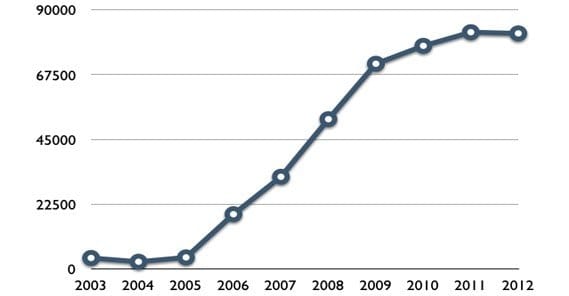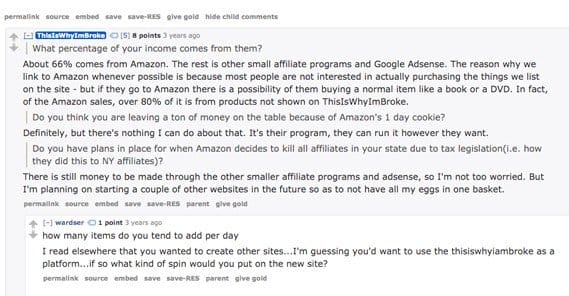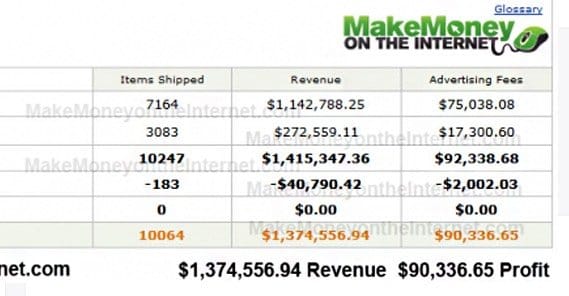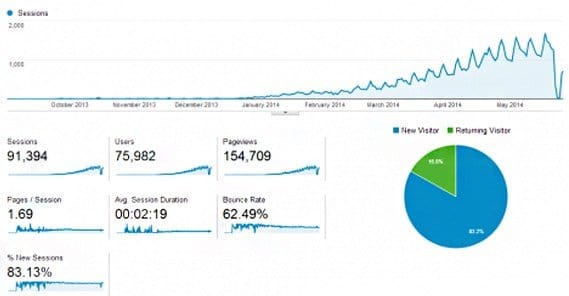5 Success Stories from Affiliate Marketers

There’s a lot of skepticism in the affiliate marketing community about how many people are actually successful out there. I can certainly appreciate why that is, too. Anyone would be skeptical if they looked around and noticed the only people making money in affiliate marketing were the people selling tools to help newbie affiliate marketers get into the game.
Combine this with the fact that so many people are stingy with their information and techniques for fear of having their niche stolen and their profits undercut, and you can see why it happens.
Sometimes, you need a good refresher about how successful actual people can be. People who post about their success, people who try to help others become successful, people who don’t care about their niche being undercut because they know they’re the best at what they do. I’ve tracked down case studies from five of these successful marketers, and that’s what I’m bringing to you today.
Don’t feel like you’re being played just because you haven’t gotten a foothold yet. Affiliate marketing takes time, to establish yourself, to build an audience, to create content, and all the rest.
Darren Rowse of ProBlogger.net
Darren is one of the most prominent affiliate marketers around, precisely because he’s always open with his history, his techniques, and his success. This post is from 2013, so he’s had three more years to rack up his success, but even then it was impressive. In 2013, it was the 10th year he had been working affiliate marketing with Amazon, and he had racked up nearly half a million dollars.
Now, $42,000 a year isn’t all that impressive, all things considered. That’s not quite the whole story, though. His earnings only really started to shoot up in 2008 or so. It’s more accurate to say that he started out making a pittance, and that in recent years he has hovered around $80,000 per year. That’s a respectable haul, and all from running a handful of websites, one of which is geared specifically towards helping bloggers reach their own success with affiliate marketing.
What’s impressive is that Darren isn’t even one of the top tier Amazon Affiliates. His experience is actually rather typical of the people who put a lot of time and effort into getting serious with affiliate marketing. There are, no doubt, much more successful affiliates.
The meat of Darren’s post is about why he chose to use Amazon for his affiliate marketing, despite all of the perfectly valid criticisms out there. Amazon commissions are small, sure, and a lot of Amazon products are cheap, so success often relies on big ticket niches – which are packed – or volume, which takes a long time to build. However, he points out:
- Amazon is a highly trusted brand, much more than many other affiliate sellers.
- One referral link works for everything a user buys in that session, whether or not you referred them to that product. If you send someone a referral for a $2 book, and they decide to buy a $900 TV, you get the commission on the TV.
- Amazon is perhaps the easiest affiliate network of all to get started using. They provide a ton of tools, easy embeds in a half a dozen different ways, and even referral tagged shortlinks.
- Amazon sells, well, everything. There’s very little that Amazon doesn’t sell, and often those categories are just MLM schemes anyways.
You can read the rest of his post above for a bunch of tips on becoming an Amazon affiliate success. Some of the tips are pretty common, like “get more traffic,” but that doesn’t change how valuable Darren’s site is as a whole. You can also listen to a more recent post about his success – showing he topped the $500K threshold – with this podcast post.
David McSweeny of Top5SEO.co.uk
David is a UK marketer and SEO expert who has been working in the industry for 15 years. He shares his methods and tips for how to create and grow a marketing site, based on his own experiences. The blog he uses for a case study went from freshly created to making just under $4,000 a month, in the span of six months. That’s remarkably fast, and stands as a testament to David’s skill as an affiliate marketer.
The meat of the post is his month by month playbook and recounting of how his site grew. The first month was all about creating and setting up the site, as well as how he chose a product and how he decided to monetize it. This highlights the sheer amount of work he put into research and content to fill his site. He dug deep into reviews for his chosen product and he wrote deep reviews stretching into the 2,500-word range. Month 1, he had just over 800 visitors and made $115.
Month 2, he made a blog to accompany his site, and he talks about how he created content, how he linked things together, and how he worked on link building. Through content and links, he boosted up to 2,200 visitors and $391 in sales. Month 3, he further expanded the blog, and his traffic continued to rise, as did his profits.
All of this shows how much work goes into running a site. His total time breakdown for the first four months reaches 234 hours of effort, creating content, researching products, building the site, and earning links. Combining this with the holiday season, his affiliate site shot up, where it has stayed since.
David’s study is a case where white hat effort can grow a site very quickly, but it does rely a little on timing, as well as a lot of research in picking the right niche. His post doesn’t go too deep into it, but you can find more about picking a niche in a post we wrote a few days ago. There’s also a ton of information on it out there on other sites, like David’s, Darren’s, and others.
This Is Why I’m Broke
The website named in the subheading there is little more than an odd product aggregator, with a focus towards interesting, often expensive, amusing stuff. I’ve seen everything from drones to pajamas, and let me tell you; it’s always tempting. Looking at their front page right now, I see things like color changing showerheads, the Playboy Mansion that recently went up for sale, a magic wand TV remote, and a dolphin-shaped speedboat. Needless to say, the selection of products on the site runs the entire spectrum of price ranges.
The site has grown immensely popular as one of the first of its kind, though its design has been mimicked endlessly in the years since it reached success. It’s estimated that, as of the time of the post I linked above, it was making an estimated $20,000 per month from Amazon affiliate sales alone, along with more from, eBay partner sales and referrals to a whole host of other sites, like ThinkGeek and Wicked Lasers.
The post I linked isn’t a direct post from the owner of the site. It’s a case study performed from the outside, so you have a better idea of how objective it is. The founder of TIWIB struggled with failed ventures before he hit upon the formula he used for the site, taking existing product affiliate pages and adding infinite scrolling, better images, and careful product selection.
The case study goes on to tell you what you can learn from the site, and how you might be able to mimic its success with a drilled down niche version of the same concept. Niche affiliate sites are typically less lucrative but easier to start than broad category sites like TIWIB, and that’s okay.
TIWIB receives millions of visitors every year and is still a very lucrative site, so you can learn a lot from watching how it works and mimicking its success.
Chris Guthrie on UpFuel
This post is very much like Darren’s post in the first section. So why do I include it? It proves to you that Darren is not a random outlier, he is – as he says – in the middle of the road. Chris’s websites combined to earn him over $45,000 annually, and would be making him more if he hadn’t sold one of his best sites for six figures.
Chris only really uses his success as a framing device for the post itself, which goes into great detail about how to get started with affiliate marketing. You can visit the post for the tips in full, but I’ll summarize them here.
- Pick a good niche. This has been hammered into any affiliate marketer time and again, so it should be nothing new to you. A good niche is the foundation of all good affiliate marketing. Don’t try to be too broad; you can always expand later.
- Use content links rather than Amazon boxes or sidebars or tables. Content links are much more commonly clicked. Just make sure you’re not trying to trick or mislead people into clicking links to Amazon that they thought went somewhere else. This includes cloaks and redirects; don’t use them.
- Make your product images into clickable affiliate links. A lot of people click images, so having them lead to the product page is valuable. I – and many other people – hate clicking an image link just to be brought to the image itself rather than something relevant.
- Link to Amazon quite frequently, but don’t overdo it so much that you earn a penalty from Google. Chris recommends 5-10 links per post, but his posts are quite lengthy. Keep track of what you’re doing and slowly push boundaries to find what threshold works best.
- Write review articles that come across as genuine; they are some of the highest converting content you can produce. You can pay people to write the reviews for you, so long as they’re well written.
- Make sure to cover the holidays and take advantage of the sales you find in your niche. Aggregate sales posts are insanely highly converting. A “Best Black Friday Deals on [Product]” post is incredibly valuable, and I’m sure you can see why.
- Gradually expand your niche and sell more and more products, both to increase variety and increase volume. If you start off by selling faucets, you can expand into more plumbing products, more bathroom fixtures, other kinds of valves, or all of them. Just don’t try to take on more than you can handle.
- Focus on small, cheap products early in the month and expensive products later in the month, so the cheap products boost your variable commission rates. Amazon’s commissions are a monthly performance test, starting at 4% and rising up to 8%. You’d rather get 8% on big purchases, so push those more when your commissions have grown.
- Make evergreen content as much as possible. Product comparison tables and recurring deals posts are both great for this. Make sure to keep them up to date and, most importantly, make sure people know they’re up to date. Update them monthly if possible, and always update the most recently edited date.
- Publish retrospective monthly bestseller lists and analysis to accompany it. If nothing else other affiliate marketers love to see what is and isn’t working, but if you’re doing everything right, they shouldn’t be able to undercut and supplant you.
- Ignore the Amazon AStore functionality completely; it’s not very useful.
Once again, we see that Amazon can be a great, lucrative place to be. However, pretty much all affiliate marketing advice works with other affiliates as well. It doesn’t matter if you’re promoting web hosting, selling products on eBay, or selling digital services for some app company; it’s all the same information.
Hieu Nguyen’s Affiliate Sale
Hieu is a marketer from Vietnam, and while his case isn’t as impressive as the others on this list, it shows the viability of a different sort of affiliate marketing business model. Specifically, what he did was build an affiliate site and then sell it for a sizable profit.
We’ve already seen how much work it is to set up and establish an affiliate site. It’s also a lot of work to maintain, but many newbie affiliate marketers believe that it’s the startup that’s the hardest part. As a consequence, they look out for affiliate marketers selling their sites, and they buy. Oh, do they buy.
Hieu’s business model isn’t designed to set up 1-2 sites and push them until they’re powerhouses he can live off of indefinitely. Rather, he builds sites and makes them moderate successes, something like a proof of concept. The site he sold in this case study took nine months to reach a monthly income level of $1,600, at which point he sold it for about 10x that amount.
There are two things to take away from this success story. The first is that, if you enjoy building sites, doing the research, and establishing the start of a business, you can still make a profit without having to maintain the site. You can simply sell it for a good chunk of change, then start over and do it all again. The second takeaway is that if you’re on the other side of the coin – perfectly capable and willing to maintain and improve a site, but incapable or unwilling to build it from scratch – you can just buy a site and go from there.
The post is an interview with Hieu, and it goes over the strategies he uses to build and rank his sites. Be aware that he does use some gray and black hat strategies, so your results may vary if you’re trying to follow in his footsteps. The post is over a year old, so some of those techniques may be more heavily penalized now than they used to be.
So there you have it; five successful affiliate marketers and the techniques they used to achieve that success. By following their guides, you too can be one of the people on a list like this someday.
 ContentPowered.com
ContentPowered.com










Thanks for mentioning me in the blog. I’m actually doing a bit better than that now from my websites but I also run some other companies as well. Currently have about 6 decent sized income streams that all add up pretty well. It’s been a lot of fun over the last several years trying new things 🙂
Excellent post, I really enjoyed it. Keep it up!